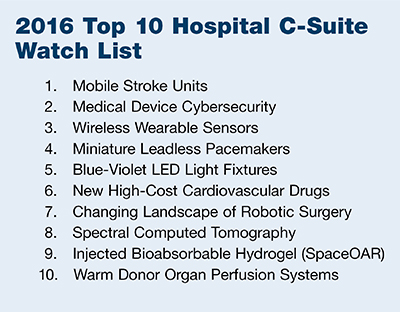Developments to Watch
Risks and Rewards on the Health Care Horizon

New developments in the health care arena will be the talk of hospital C-suites this year.
To kickstart those discussions, the nonprofit ECRI Institute published its “2016 Top 10 Hospital C-Suite Watch List.” The list includes a cross-section of technological advances and technology use issues likely to have the most impact on the industry in the coming year.
Some items on the watch list have the potential to significantly improve patient outcomes while reducing liability and litigation risks for health systems, while others highlight areas of concern for hospital and health system risk managers.
Mobile stroke units, topping ECRI’s list this year, are ambulance-like units that could significantly improve outcomes for stroke victims.
A key factor in stroke survival and recovery is whether the patient receives an injection of tissue plasminogen activator (tPA) soon after the onset of symptoms. In the traditional model of treatment, fewer than 7 percent receive tPA within the proscribed timeframe.
Mobile stroke units (MSUs) allow facilities to dispatch specific equipment and emergency personnel directly to suspected stroke victims. Only a handful of units are currently in operation, most of which are retrofitted ambulance vehicles equipped with CT scanners, tPA infusion lines, and telemedicine setups with broadband access, so that field personnel can connect with neurologists on-site for assessment.
 MSUs could be a game-changer for patient care, cutting time to administration of tPA by half, said Diane Robertson, ECRI’s director of Health Technology Assessment Information Services, at a media briefing in early February.
MSUs could be a game-changer for patient care, cutting time to administration of tPA by half, said Diane Robertson, ECRI’s director of Health Technology Assessment Information Services, at a media briefing in early February.
However, hospitals that invest in them will need to consider the cyber security of the connection, which could extend a facility’s cyber vulnerabilities far beyond its physical walls.
A dynamic change in the field of robotic surgery landed at No. 7 on ECRI’s list.
Numerous hospitals have robotic surgery equipment that is nearing the end of its useful life. But some facilities may want to press pause before making any decisions about new investments, said Robert Maliff, director of ECRI’s Applied Solutions Group.
That’s because new competitors are finally entering the market this year after a 15-year monopoly held by Intuitive Surgical and its da Vinci robot series.
At the same time, the list of procedures that can be performed robotically is growing, meaning that hospitals will need to evaluate the scope of their robotic surgery programs, and carefully weigh their needs, goals, risks and expected outcomes before making any decisions about capital investments.
The adoption of warm donor organ perfusion systems — No. 10 on the watch list — is being watched closely by many in the industry. More than two-thirds of donated organs are never used because the current process of harvesting, preserving and transporting organs can diminish the viability of organs for transplant.
By contrast, warm perfusion systems allow organs to continue functioning outside the body in an artificial environment that mimics the body. This allows physicians to verify the function of donated organs that might otherwise be deemed unsuitable without a means of assessment.
A warm perfusion system for lungs is currently available. A system for hearts is expected to be on the market early this year, with systems designed for other organs still in development.
The technology has the potential to double the number of lung and heart transplants, reported ECRI, but hospitals must ensure against the risk of overwhelming their transplant staff and transplant center infrastructure.
No. 5 on the watch list offers the potential for significant benefit for a much more modest investment. Specially designed blue-violet LED light fixtures, recently introduced to the market as Indigo-Clean, have the potential to sharply reduce the presence of bacteria that causes hospital-acquired infections (HAIs).
According to the CDC, about 2 million HAIs occur annually, resulting in 100,000 deaths and $28 billion to $45 billion in excess health care costs. Hospitals that fall into the lowest quartile, based on HAI rates, are penalized by the Centers for Medicare & Medicaid Services.
Current disinfection methods are reasonably effective, said Linda Gross, clinical writer for ECRI’s Health Technology Assessment Information Systems, but bacteria levels begin to rise again as soon as the disinfection treatment ends. And some current methods can’t be used in occupied rooms because of the potential for hazardous exposure.
Blue-violet LED fixtures are designed to provide continuous disinfection, and pose no risks to occupants. Their use is not yet widespread, but early studies are overwhelmingly positive.
One study in a non-surgical setting measured a 90 percent reduction in surface bacteria in unoccupied rooms, and a 56 percent to 86 percent reduction in rooms occupied by a MRSA-infected patient.
In another study conducted in a patient-occupied intensive care unit, bacterial counts were reduced by up to 67 percent.
ECRI’s complete report is available online. Other items rounding out the list this year are wireless wearable sensors, miniature leadless pacemakers and new high-cost cardiovascular drugs.










